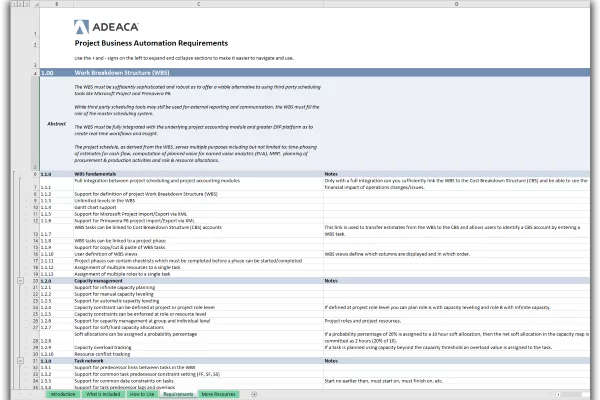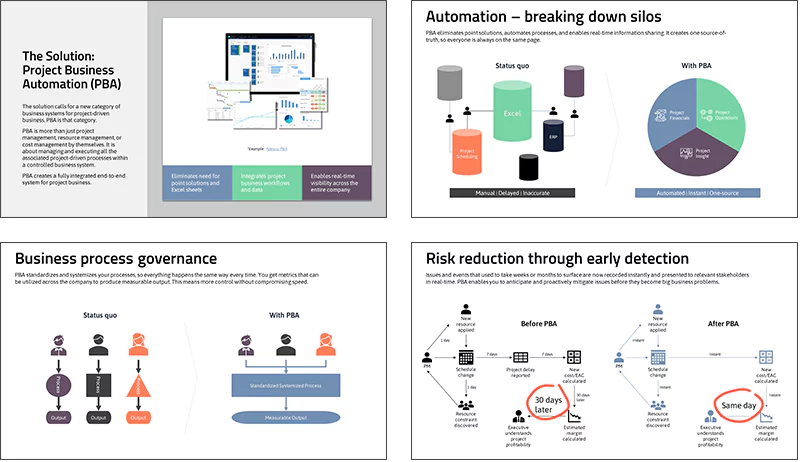Selecting the most suitable project management system is a pivotal decision that holds the potential to significantly influence project efficiency and, consequently, overall business success. To guide you through this crucial process, let’s delve into a detailed exploration of 5 key steps:
A Project Management System is different than a Project Management Information System or PMIS. The PMIS manages information and is more of a reporting system, while the PMS manages projects tactically as well.
1. Define the business problem you are trying to solve.
Assess critical business impacts
- Evaluate the impact on revenue.
Understanding how the project management system affects revenue is paramount. Consider factors such as improved project efficiency leading to quicker deliverables and client satisfaction, potentially resulting in increased business and revenue.
- Consider the influence on profit margins.
Evaluate how the system can contribute to cost savings, resource optimization, and efficient project delivery, all of which can positively impact profit margins.
- Gauge the effect on risk management.
Examine how the system addresses risk factors inherent in your projects. A robust project management system should offer tools for proactive risk identification, assessment, and mitigation.
- Examine the potential impact on volatility.
Consider how the system contributes to stabilizing project processes, reducing uncertainties, and minimizing the volatility that may affect project outcomes.
Choose the right project management system to deliver on these business problems.
- Prioritize enhanced process control.
Look for a system that provides robust control and governance over project processes. This includes features that allow you to define, monitor, and optimize workflows, ensuring a streamlined and efficient project environment.
- Seek systems offering visibility and real-time insight into projects and overall business operations.
Opt for a system that offers comprehensive visibility into project progress, resource allocation, and financial metrics in real-time. This transparency is crucial for informed decision-making and timely interventions.
- Emphasize transparency to prevent information obfuscation behind manual processes.
Select the best project management system that minimizes manual interventions and ensures transparent data flow. This reduces the risk of crucial information being obfuscated or misinterpreted due to manual processes.
2. Identify Necessary Capabilities
Specify Project Management Needs
Considering the size and complexity of your projects, clearly outline your project management needs. Identify key aspects such as collaboration requirements, task management intricacies, resource allocation challenges, and reporting preferences.
Consider the size and complexity of projects.
Analyze the scale and intricacy of your projects to determine the level of sophistication required from the project management system. Larger and more complex projects may necessitate advanced features and capabilities.
Determine essential features.
List down the essential features crucial for your project management needs. This may include robust task management tools, efficient resource allocation functionalities, seamless collaboration features, and comprehensive reporting capabilities.
Avoid unnecessary features that don’t provide significant value.
While considering essential features, be discerning about functionalities that add substantial value. A focused approach ensures a streamlined and user-friendly system.
3. Explore Project Management System Options
Research and Compare
Shortlist potential systems based on features, budget, and team size. Conduct thorough research to identify project management systems that align with your specific needs, budget constraints, and team size. Create a shortlist of 3-5 potential systems that seem to be promising fits.
4. Evaluate Options
Base Evaluation on Requirements
When evaluating options, ensure that your requirements serve as the foundation. However, adopt an open-minded approach, recognizing that rigid adherence to a myopic list might overlook critical aspects or weigh trivial features equally with essential ones.
Embrace an open-minded approach, avoiding a myopic view of requirements.
Be receptive to exploring beyond the predefined requirements. Acknowledge that certain aspects vital to your project’s success might not be explicitly outlined in your initial requirements.
Encourage exploration beyond standard demonstrations.
Move beyond standard demonstrations. Engage with the vendor to explore the system in depth, encouraging interactive discussions about various options and potential customizations.
Why software demonstrations don’t work
Demonstrations are typically:
a. Limited in scope and time. They are based on narrow scripts that don’t allow for interaction and exploration.
b. They are one-way, where the vendor is delivering a pitch instead of focusing on understanding.
c. Misunderstandings and misinterpretations are likely.
d. They are not interactive. No one speaks up because too many people are “in the room.”
e. Not enough information to make a confident business decision.
Make the evaluation interactive and engage in discussions about options.
Ensure the evaluation process is interactive. Engage in open discussions with the vendor, discussing not only features but also the adaptability of the system to your unique business processes and workflows.
Focus on Critical Aspects
- Completeness:
Look for a system that covers most of what you need to manage your project business. For example, in a system, you don’t want to break up your critical processes across applications. Try to find a fully integrated system capable of managing your projects from start to finish bot operationally and financially. Take a look at Project Business Automation as an example.
- Scalability:
Assess the system’s ability to accommodate your company’s growth. Consider projected increases in the number of projects, users, and data volume. Choose a system that can scale with your evolving business needs.
Ensure the system can handle an increasing number of projects, users, and data volume.
- Integration Capabilities:
Confirm the system’s ability to seamlessly integrate with other tools and software your company uses. This is crucial for avoiding data silos and ensuring a smooth flow of information across different systems.
Seamless integration enhances data flow and avoids duplication of efforts.
However, just because the system has an API does not mean you should rely on system-to-system integrations. Look for a system that is capable of all your project business needs in one place.
- Customization Options:
Evaluate the level of customization the system offers. A system that can be tailored to match your company’s unique workflow and processes ensures a seamless fit with your existing operations.
Ensure it can be tailored to match your company’s unique workflow and processes.
Project Business Automation (PBA) is a comprehensive business system for project-driven organizations. Learn more: Download the PBA Quick Guide now.
5. Make an Informed Decision
Engage in Workshops
Collaborate with the vendor to ensure the system aligns with your company’s needs and ensure you select the best project management system for your company.
Consider engaging in workshops with the vendor, providing an opportunity for in-depth discussions and hands-on exploration. Ensure that the system aligns with your company’s specific needs and expectations.
Remember, the best project management system is not one-size-fits-all. Take the time to conduct thorough research, explore options, and involve your team in the decision-making process. Following these steps will guide you towards selecting a system that empowers your team, enhances project success, and propels your company toward its strategic goals.














